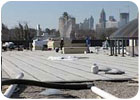Low-slope roofing involves a lot of science to achieve great results. From multiple materials technologies to the design, engineering, and estimating to the planning that it takes to perform the work, the variables are complex and intertwined. When it comes down to actually performing the work of demo and replacement, however, there is often a considerable amount of artistry on display. Roofing Contractor was invited to bear witness as Ben Hill Roofing and Siding Co. Inc. of Douglasville, Ga., painted a masterpiece atop the main building of the Atlanta Decorative Arts Center.

Low-slope roofing involves a lot of science to achieve great results. From multiple materials technologies to the design, engineering, and estimating to the planning that it takes to perform the work, the variables are complex and intertwined. When it comes down to actually performing the work of demo and replacement, however, there is often a considerable amount of artistry on display. Roofing Contractor was invited to bear witness as Ben Hill Roofing and Siding Co. Inc. of Douglasville, Ga., painted a masterpiece atop the main building of the Atlanta Decorative Arts Center.
The Roofing Contractor
Ben Hill Roofing was named by founder Carroll L. Welch for the section of southwest Atlanta where the firm got its start. Welch, following a tour of duty in Korea, started work in Atlanta as a part-time fireman and part-time roofer. Originally from Connecticut, he had worked with his brother as a roofer in New Hampshire. In 1964, Welch decided to go out on his own and formed Ben Hill Roofing and Siding Co.Fast-forward to the late 1970s, when Welch's son, David, was working his way up in the business. Starting while still in school, David was a foreman by the time he graduated. In 1984, the elder Welch passed away, and David Welch had to step into a senior role with the firm while still in his early 20s. Today Ben Hill Roofing and Siding is a formidable contracting firm, employing just less than 50 with annual sales of $8 million.
The firm is guided by a 10-point code of ethics that is prominently displayed and is a part of the training for all company personnel. The code upholds the company's mission and vision statements and includes key goals, such as "Zero Callbacks," "Zero Punch List," "Zero Accidents," and respect for co-workers, customers, vendors and others. The No. 1 point in the code is striving to achieve "100% Customer Satisfaction" on each job.
Ben Hill Roofing's output is roughly 75 percent commercial, primarily built-up and modified bitumen. The remainder is in residential roofing and siding, primarily asphalt shingles. Metal work and numerous other services round out the BHR portfolio. Headed by David Welch, the firm's other key people include Gary Woodall, who manages the residential division; Brett Dunn, manager of the commercial division; and Roger Gray, commercial estimator.

RK Hydro-Vac was contracted to remove the existing stone on the building's roof.
The HVAC contractor who was performing some remedial work in preparation to replace the rooftop units originally called Ben Hill onto the job for some repair work. One thing led to another, and Ben Hill's estimating team began the long process of submitting pricing for a number of systems to replace the entire roof.

Ben Hill Roofing was called in to handle the reroofing job for the main building of the Atlanta Decorative Arts Center.
Special Requirements
So you have an owner with a building full of independent businesspeople who are, for the most part, very particular, with a very particular clientele. The first rules on day one of this project were: nothing could be in the way of clients coming and going, no noise, and, for goodness sakes, no smells. In other words, this had to be a "stealth" retrofit roofing job. In order to manage the project successfully, Welch maintained regular - often daily - communication with the owner.The existing roof on the main building consisted of roughly 800 squares of an inverted roof membrane assembly (IRMA) low-slope roofing system. The concrete deck was waterproofed with a self-adhering membrane that was topped with a couple of inches of an extruded polystyrene insulation. Over that a polyester scrim was topped with a layer of 1- to 2-inch stone.
The final system selected included removing the stone, scrim, and insulation and replacing it with a layer of new polyiso insulation and a two-ply modified bitumen system. While a number of other systems were seriously considered, the one deemed to deliver the most value was the one proposed by Firestone Building Products (www.firestonebpco.com). Key to the system's success was the removal of the existing gravel and insulation followed by the installation of the polyiso insulation with a non-penetrating low-rise foam adhesive. Firestone was also able to provide a "hybrid" system that also consisted of EPDM on the parapet walls.

A truck-mounted tank supplies the power for the vacuum system.
Let the Work Begin
In order to keep the dust, noise, and smells to an absolute minimum, RK Hydro-Vac was contracted to remove all the stone. The enclosed vacuum system used was capable of keeping up with the progress of the work while keeping the peace with the owner. The vacuum work was completed entirely on the weekends and the owner was able to make use of all the stone on the property. The only challenge the vacuum operators had was the scrim, which came apart in some sections, causing the vacuum inlet to jam. The operators quickly figured ways to work around this inconvenience and managed to stay on track. The roof vacuum system consists of a truck-mounted tank and vacuum system from which a series of 6-inch hoses and PVC pipes terminate with a pickup wand. While the truck-mounted system is very sophisticated, the "secret sauce" for keeping it going is a series of hoses and pipes kept sealed tight with the underrated and much-maligned duct tape. RK Hydro-Vac (www.rkhydrovac.com) operates out of three central offices and works across the country.
The pull test is administered on a test sample.
OMG representative Jed Breitbart conducted the testing on a clear day in the early spring just before the work began. Utilizing an ASTM standard, a section of the existing gravel was moved away and enough scrim and insulation were cut away to make room for a 12-inch by 12-inch test sample and testing apparatus. The sample consisted of a "sandwich" of the polyiso insulation to be used and a piece of plywood. The two-part adhesive was extruded onto the existing membrane in the specified amount and, after a few short moments allowing the foam to rise, was set in the adhesive. The plywood was attached to the polyiso in the same fashion.
Once the sandwich had time to set, the testing apparatus was mechanically attached to the plywood and the test began. The pull test measured the number of pounds per square inch that it took for the polyiso to come detached from the membrane. On the first two of four tests conducted, the plywood separated from the polyiso before the polyiso separated from the existing membrane. The tests revealed that there was sufficient pull strength to pass the requirements, so work could proceed as specified.

Workers install the two-part adhesive.
By the time Ben Hill Roofing started work, the HVAC units were substantially replaced. This required them being jacked up for membrane and flashing installation. The units sit on pillars just as they had on the original membrane installation. Working around the units posed some unique challenges due to their proximity to the high parapet wall that surrounded the entire building.
Working in sync with RK Hydro-Vac, Ben Hill crews removed the polystyrene insulation and were able to salvage around half of it for later use. In fact, roughly 350 squares have been recycled and are in service on other jobs. Welch was happy to have it, since this coincided with the time when polyiso insulation prices were rising rapidly and availability, which has since improved greatly, was tough.
The high parapet was a blessing, as it substantially provided fall protection while working on the inside. There was another four or five feet of roofing with a unique flashing detail on the outside of the parapet, and workers used a personal fall arrest system while performing all of that work. As previously noted, the inside of the parapet wall is covered with EPDM. Ben Hill's mechanics installed this membrane with great attention to detail evidenced by its smooth, taut appearance.
Installation of the polyiso insulation and the modified bitumen membrane was performed without a hitch. The modified system went down with a combination of adhesives and torching in two plies. The top ply has a white mineral-surface with walking pads installed adjacent to the roof-mounted HVAC systems. All metal flashings are new, including a new metal coping on the parapet wall.

Stocking the job took place only on weekends and off hours so as not to disrupt the building's functions.
For Better or For Worse
Any retrofit roofing job with a price tag just under $600K is going to have some pain associated with it. Welch says the key tactic employed to keep problems at a minimum by Ben Hill Roofing on this job was to "know your client" and communicate with them every day. While the client had numerous and stringent requirements, everything was smooth so long as they knew what was coming.The result was walking away from the reroof of the main building for ADAC with "zero punch list" results and a building full of satisfied art and décor dealers.

The completed walkways facilitate access to HVAC equipment.
No Honeymoon
The great news for Ben Hill Roofing was being awarded several other ADAC buildings. Unfortunately, however, the going was not so easy on one of them, as the project now required tearing off built-up roofing over lightweight concrete. The impact of roof removal caused dust inside the building that had no drop ceiling. As this building accommodated the same type of clientele as the main building, special arrangements were made to schedule roof removal.Returning to the idea that great communication eases a lot of pain, Ben Hill did manage to get the work progressing to everyone's satisfaction. The exercise was a new lesson in "knowing your client," since these particular people are artists and they are exceedingly particular about their products and surroundings. While working on the additional buildings, Ben Hill had to shut down projects for days at a time during several of ADAC's festival events. There could be no evidence that work was taking place there, right down to removing the warning lines from the perimeter of the building. The work on this contract, which totaled just over $400K, was completed successfully, and the many purveyors of fine art and furnishings are busy showing their wares to their well-heeled clientele.
At the end of this project, the company can stand back and admire a job well done. The ownership, management, and working crews of Ben Hill Roofing and Siding Company can point to the Atlanta Decorative Art Center project with the kind of pride an artist would truly understand. Now, like any artist, the firm has hung this one in their gallery and has moved on to the next canvas.

Report Abusive Comment